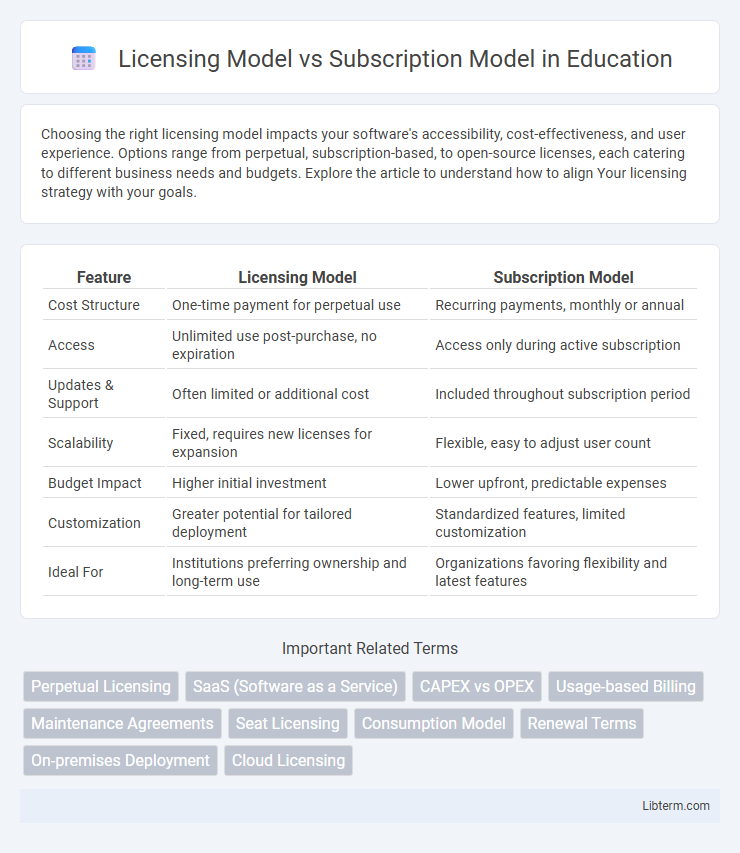Choosing the right licensing model impacts your software's accessibility, cost-effectiveness, and user experience. Options range from perpetual, subscription-based, to open-source licenses, each catering to different business needs and budgets. Explore the article to understand how to align Your licensing strategy with your goals.
Table of Comparison
| Feature | Licensing Model | Subscription Model |
|---|---|---|
| Cost Structure | One-time payment for perpetual use | Recurring payments, monthly or annual |
| Access | Unlimited use post-purchase, no expiration | Access only during active subscription |
| Updates & Support | Often limited or additional cost | Included throughout subscription period |
| Scalability | Fixed, requires new licenses for expansion | Flexible, easy to adjust user count |
| Budget Impact | Higher initial investment | Lower upfront, predictable expenses |
| Customization | Greater potential for tailored deployment | Standardized features, limited customization |
| Ideal For | Institutions preferring ownership and long-term use | Organizations favoring flexibility and latest features |
Introduction to Licensing and Subscription Models
Licensing models grant customers the right to use software indefinitely with a one-time fee, often including optional maintenance or upgrades. Subscription models provide access to software through recurring payments, ensuring continuous updates and support throughout the subscription period. These models differ in cost structure, flexibility, and software ownership, impacting budgeting and user experience.
Defining the Licensing Model
The Licensing Model grants customers the right to use software through a one-time purchase, offering perpetual access without ongoing fees. This model typically involves a fixed cost for a specific version or number of users, allowing organizations to control expenses and avoid recurring charges. Licensing ensures clear ownership and usage rights, often accompanied by optional maintenance and upgrade plans.
Understanding the Subscription Model
The subscription model offers customers continuous access to a product or service through recurring payments, typically monthly or annually, enabling predictable revenue streams for businesses. It reduces upfront costs for users while providing ongoing updates, support, and often cloud-based features, enhancing value over time compared to one-time licensing fees. This model drives higher customer engagement and retention by aligning service delivery with evolving user needs and technological advancements.
Key Differences Between Licensing and Subscription
The Licensing Model typically involves a one-time purchase granting users permanent access to software, whereas the Subscription Model requires ongoing payments for continual access and updates. Licensing often limits software usage to specific devices or users, while subscriptions enable flexible access across multiple platforms with regular feature enhancements. Cost structure in licensing is upfront and fixed, contrasted with the recurring, scalable fees in subscriptions that adapt to user needs and service tiers.
Cost Implications: One-Time Fee vs Recurring Payments
The Licensing Model requires a one-time fee, providing immediate ownership but often involving higher upfront costs and potential expenses for updates or support. The Subscription Model involves recurring payments, generally lower initially, distributing costs over time with continuous access to updates and support included. Businesses must evaluate cash flow, budget predictability, and long-term value when choosing between upfront investment and ongoing operational expenses.
Flexibility and Scalability Considerations
The licensing model offers fixed software usage rights with limited flexibility, often requiring upfront payments and restricting scalability based on predefined terms. In contrast, the subscription model provides greater flexibility and scalability by allowing users to adjust service levels and pay incrementally as needs evolve. This adaptability makes the subscription model ideal for businesses experiencing fluctuating demands or rapid growth.
Impact on Software Updates and Support
The licensing model typically offers a one-time purchase granting perpetual use, but software updates and support are often limited to a specific period or version, requiring additional fees for major upgrades. In contrast, the subscription model ensures continuous access to the latest software updates and dedicated support as part of an ongoing payment plan, promoting improved security and feature enhancements. This ongoing service approach in subscriptions aligns with evolving technology demands and user needs, reducing the risk of software obsolescence.
Customer Ownership and Access Rights
The Licensing Model grants customers ownership of software with a one-time purchase, allowing indefinite use and control over the licensed version without ongoing fees. The Subscription Model provides customers access rights through periodic payments, enabling continuous updates and support but without transferring ownership. Ownership under licensing ensures full control, whereas subscription emphasizes access and service continuity.
Choosing the Right Model for Your Business
Selecting the right licensing model versus subscription model depends on your business goals, cash flow preferences, and customer engagement strategy. Licensing models provide upfront revenue with fixed costs, ideal for companies seeking long-term asset ownership and fewer ongoing management needs. Subscription models offer predictable recurring income and continuous customer interaction, best suited for businesses emphasizing service updates, scalability, and strong customer retention.
Future Trends: Evolution of Software Monetization
The future of software monetization is shifting from traditional licensing models to flexible subscription models, driven by increasing demand for scalability and continuous updates. Subscription models enable predictable revenue streams and enhanced customer engagement through cloud-based delivery and regular feature enhancements. Emerging trends also highlight hybrid models combining perpetual licenses with subscription services to cater to diverse customer needs and maximize market reach.
Licensing Model Infographic

 libterm.com
libterm.com